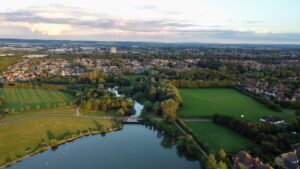Urban areas with more green space, higher density of buildings and facilities, lower population density and no major roads have been linked to better children’s health behaviours.
Research led by Barcelona Institute for Global Health (ISGlobal), supported by “la Caixa” Foundation, identified the link after studying physically activity undertaken by children.
The study showed that children living near more natural spaces are more physically active, spend less time doing sedentary activities, get more hours of sleep and are more likely to walk or cycle to school.
Previous studies have focused only on the effect of the urban environment on adults and didn’t explore all factors, while this new study explored the effects on 1,581 children aged 6-11 from six European countries.
A large proportion, 63.6%, did not meet World Health Organisation recommendations for at least 60 minutes of physical activity a day, with 58.6% of the children spending more than two hours a day watching TV or playing video games.
‘Our findings have implications for urban planning policies,’ said Martine Vrijheid, head of ISGlobal’s Childhood and Environment programme and last author of the study. ‘Public health interventions tend to focus on influencing individual behaviours rather than tackling the broader system determinants that drive these behaviours and widen health inequalities.
‘Our evidence reinforces the need to prioritise urban design to improve health-promoting behaviours in children and prevent ill health in adults.’
Researchers identified 32 characteristics of urban environments, such as traffic density and green and blue spaces, and estimated children’s exposure to these elements near their homes and schools.
They also collected information regarding children’s health habits, including how much time they spent doing moderate-to-vigorous activity, physical activity outside of school hours, active travel and sedentary activities, like sleep.
According to the results, active travel increased and time spent on sedentary activities decreased in places where children were more exposed to green space.
Closeness to a major road was also associated with a shorter sleep duration, with those living close by sleeping around 5 minutes less each night than those who didn’t.
The results suggest the number of green spaces and vegetation on streets need to be increased, according to authors of the study.
Vrijheid added: ‘We need further research that includes other urban indicators that may be relevant for the behaviour of children and adolescents, such as pedestrian zones and sport facilities (for example, ping-pong tables, volleyball courts, etc.), and which looks at more countries and less-studied areas in order to better assess how changes in the urban environment affect people’s lifestyles.’
In related news, green spaces in England and Wales are worth £25.6bn each year, according to research funded by the Department for Environment, Food, and Rural Affairs.
Photo by Kelly Sikkema


















Leave a Reply